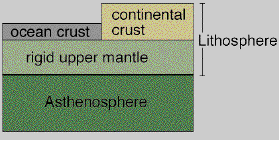
The "simplicity" of the mineralogy of the crust and mantle reflects the fact that eight chemical elements -- oxygen, silicon, aluminum, iron, calcium, magnesium, sodium and potassium -- account for about 99% of the weight of the crust and of the mantle.
The crust is enriched in oxygen, silicon, alumnium, potassium and sodium. The mantle is enriched in iron, calciuim and magnesium. The oceanic crust has a composition intermediate between the continental crust and the mantle.
The most common minerals in the crust are silicates -- combinations of oxygen, silicon, and (usually) other positively charged ions.
The Mineral Gallery offers a full text search ability which you will use to complete this exercise.
Take a look at Appendix B of your text for some additional information about minerals
Olivine and pyroxene are both solid solution series and are common silicate minerals concentrated in the mantle.
A few minerals form primarily near the surface and are concentrated in sedimentary rocks -- halite (salt), calcite (calcium carbonate - CaCO3) and dolomite (calcium and magnesium carbonate - CaMg(CO3)2).
Physical Properties at the Mineral Galleries contains good discussions of the physical properties of minerals. Read the section on Specific Gravity.
| Mineral Name | Specific Gravity | Location |
|---|
For location. tell where the mineral or mineral group is concentrated : (1) continental crust, (2) oceanic crust, or (3) mantle. In general, high pressures favor higher densities and high temperatures favor lower densities. Within the outer part of the Earth, the pressure effect tends to dominate.
From your table, generalize about the relationship between specific gravity and the concentration of these common minerals.
The Behavior of Melts
Basalts (and Gabbros) are igneous rocks rich in Ca-Plagiocalse, Olivine and Pyroxene. Andesites (and Diorites) are igneous rocks with Na-Plagioclase and Pyroxene. Rhyolites (and Granites) are igneous rocks with Quartz and Alkali Feldspar.
In general, the viscosity of a melt (a measure of its resistence to flow) is inversely proportional to its temperature. At high temperatures the melt tends to flow more readily than at low temperatures. Water can drastically modify the viscosity of a melt; the higher the water content, the lower the viscosity.
Questions
| jbutler@uh.edu
|E-mail the ClassListserv|Read the ClassListserv|
|Textbook Home Page
|Glossary of Geologic Terms|Search These Pages|
|Other Courses|Resources|Grade Book|
Return to the Physical Geology Home Page
Copyright by John C. Butler, July 29, 1995